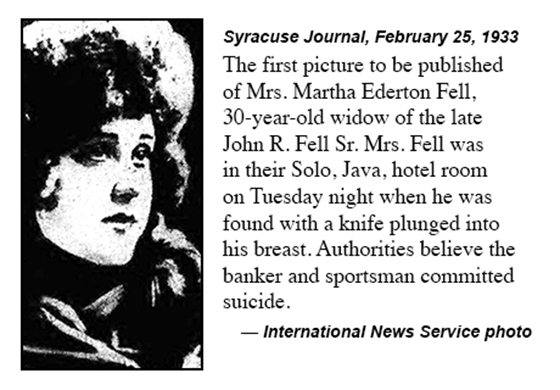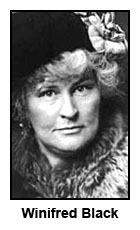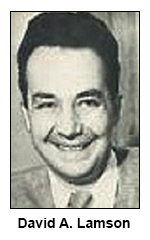| HOME • FAMILY • YESTERDAY • SOLVAY • STARSTRUCK • MIXED BAG |
 |
 |
Every year brings deaths that cannot be easily explained. Such mysteries may be solved by the likes of Lieut. Columbo, Miss Marple or Jessica Fletcher, but, alas, truth is stranger than fiction, and where there is no hard evidence, some crimes — if, indeed, they are crimes at all — might as well be solved by a coin flip. Here are two deaths from 1933 that defy re-enactment — unless you choose to believe murder was committed, but don't concern yourself with motive, method or hard evidence.. The first mystery, because of its location, probably would be a better fit for Miss Marple than Lt. Columbo, but the second one has Columbo written all over it. And then there are two New England murders that would be right up Jessica Fletcher's alley. |
|
|
|
|
|
 |
|
| The official ruling was accidental death, which sounds far-fetched until you consider his fatal wound was inflicted by a table knife, not a weapon you would choose to commit suicide or murder. But, then, any ruling would be more conclusive coming from an Agatha Christie crime-solver. | |
My expert's smarter than your expert But something bad did happen, something that in many ways was a precursor to Ohio's famous Sam Sheppard case. |
|
|
|
This death was a newspaper editor's dream — "beauty" in the headline, "nude body" in the second paragraph, a former President as a neighbor, and an educated, well-regarded husband as the prime suspect. Additionally, the location of the body — did I say "nude body"? — allowed for two scenarios: Allene Lamson was beaten over the head, perhaps by a lead pipe, or she slipped in the bathtub and hit her head on the nearby sink. The scene had been disturbed by the husband, which hampered the investigation. It was never established where the body was, exactly, when Mrs. Lamson died. Was she in or out of the tub? Lamson claimed the body slipped back into the tub when he went into the bathroom and found her sprawled across the edge of the tub, half-in, half-out. He cradled her head, he said, which accounted for the blood on his shirt. But just when did he put on the shirt? Minutes before Mrs. Lamson's body was discovered, her husband was in the backyard, shirtless, burning trash. A real estate woman and a client dropped by unexpectedly, hoping to look at the cottage where the Lamsons lived. David Lamson led them in, excused himself and went looking for his wife. He broke down crying when he found her. Police were called. Lamson said his wife's death must have been an accident or the result of a beating by a prowler, which seemed highly unlikely since the husband was on the premises, though Lamson admitted that one door to the cottage was always unlocked. Police weren't buying Lamson's story. They believed he had killed his wife in the bathtub, then went casually outside to burn trash. A piece of pipe would be found among the ashes, and on that pipe would be traces of blood. At least that's how police viewed the splotches. Police also said Mrs. Lamson's head had been struck four times, which obviously would have ruled out an accident, unless the woman's head Interpreting what little evidence was available would lead to a courtroom battle of experts, and that inspired this amusing report by Hearst columnist Winifred Black, who, at the age of 70 was nearing the end of her long career as one of the journalism's best-known "sob sisters." During the Lamson trial, Ms. Black was clearly annoyed by the tactics and performances of attorneys and witnesses for both sides, but she was especially peeved at the "experts." |
|
|
|
If David A. Lamson did kill his wife, what was his motive? Usually it's sex or money or both. In this case the prosecution decided it was strictly sex, but while there was much talk about Lamson's alleged affair with a San Francisco divorcee, the state failed to produce a witness to testify on the matter. Yes, Lamson, in his role with Stanford's University Press, had met with a woman in Sacramento, a woman who wrote and edited a newspaper garden page. Lamson claimed these meetings had to do with University Press possibly publishing a gardening magazine. Police found two love poems in Lamson's possession, poems written by the Sacramento woman. He claimed she had given them to him to read and critique, and apparently it was easy to believe he held on to them because he couldn't bring himself to tell her that her poetry was not very good. Also, it turned out this woman was engaged to someone else and would soon be married. There also was a well-circulated rumor that the problem between David and Allene Lamson indeed was sex. Seems she didn't enjoy sexual intercourse, especially after the birth of their daughter two years before her death. The story was she used any excuse to avoid having sex and that her husband's frustration boiled over on the day he allegedly killed her. This would seem to be a very private matter, but perhaps Lamson or his wife confided in someone, and, as we all know, all it takes is one person to launch the gossip that soon will be heard around the world. And no California case would be complete without a message from the afterlife: |
|
|
|
As the trial wound down, Winifred Black, at least, was convinced the state had not made its case. The jury, however, disagreed, though it took a few hours for the eleven members who voted "guilty" to convince the twelfth member to change his or her mind. And so it was that David Lamson was convicted of murder and sentenced to hang. Universal Press Syndicate published the following story, written by one of the jurors, who recounted the interesting way the jury arrived at its decision: |
|
|
|
But the case wasn't over, not by a long shot. In this country you cannot retry a person who has been found not guilty, but you can retry a person who was found guilty. Lamson remained on death row long enough to get material for a book that he would write ("We Who Are The third trial was aborted before it could begin, because of a problem with the jury pool, but the state regrouped and tried Lamson one more time, again in front of a jury who voted 9 to 3 in favor of guilty. Lamson went free when the state chose not to try him again. (If you're keeping score, that's 30 jurors who thought he was guilty, only six who voted for aquittal.) The California Supreme Court, in overturning the first trial, had done so on the grounds the judge had not permitted the defense to explore an alternative solution to the crime. In a highly unusual move, Chief Justice William Waste admitted that a majority of the justices felt Lamson was guilty. Nonetheless, they ruled the second trial was necessary. One wonders what Lieutenant Columbo would think, and if he believed it was murder, how he would have proven it. In 1936 Lamson married Ruth Smith Rankin. A year later the movie, "We Who Are About to Die," based in part on his book, was released. Lamson wrote short stories — about 90 of them — over the next 15 years, then took a job with United Airlines. He and his second wife remained married until Lamson's death in 1975. |
|
|
|
 |
|
| The next murder — well, there were two of them, actually, but one occurred in 1932 — took place in Rockport, Massachusetts, but it's no stretch at all to say what happened would have been perfectly placed in an episode of "Murder, She Wrote." | |
|
|
| The murder prompted an unusual response from police, one that could be made only in a small town, though a population of 3,700 seems a bit too large for this particular investigative tactic: | |
|
|
Alas, none of the residents was named Jessica Fletcher, so the house-to-house investigation failed to reveal the killer. What made this case especially troublesome was that 17 months earlier another resident of Rockport was murdered. Arthur Oker, 57, was a tailor who was bludgeoned to death in his shop about noon on May 21, 1932, a Saturday, the busiest shopping day of the week. Yet there were no witnesses to the brutal crime. What linked the victims was the Swedish Congregational Church, which had a small membership — one story put the figure at 60. Oker was an active member. Mrs. Johnson didn't belong to the church, but on October 31, 1933, attended a Halloween party at the church. Some who also were present at the party told police and reporters that Mrs. Johnson claimed to know the identity of Oker's killer, and announced she would tell police the next day. True or not, this story led police to strongly suspect the murderer was a member of the church and likely attended the party, following Mrs. Johnson when she returned to her home. Adding to the intrigue about the church was the fact the Rev. Albert M. Johansen, the pastor, was assaulted soon after he arrived in Rockport in 1932. A story written by Ethelda Bedford for publication in several regional newspapers on November 27, 1933, claimed that the Rev. Johansen and many other Rockport residents had taken to carrying guns wherever they went. Police remained convinced the killer was a Rockport resident. The community, after all, existed at the tip of Cape Ann, at the very end of Cape Cod. It was nearly winter and Mrs. Johnson was killed after midnight. It wasn't likely that an out-of-towner was responsible. However, 3,700 suspects were too many, and the case quickly cooled. By the end of November the state police and other out-of-town investigators were gone. Rockport went into hibernation for the winter, but a year later there was a disturbing report that resulted in this brief, yet over-the-top story from International News Service: Despite the intense interest and the extensive questioning of locals, the two murders and the assault of Rev. Johansen were never solved. That wouldn't be true in an episode of "Murder, She Wrote." |
|
|
|
Despite the intense interest and the extensive questioning of locals, the two murders and the assault of Rev. Johansen were never solved. That wouldn't be true in an episode of "Murder, She Wrote." What Jessica Fletcher would have done, of course, is to follow Augusta Johnson's lead. She'd loudly announce she knew the identity of the murderer, then set a trap when he (or she) showed up to kill the busybody mystery writer. |
|
| HOME • CONTACT | |
 ricocheted from the sink to the tub to the floor. No matter. Lamson's attorney would claim there was only one wound on the woman's head.
ricocheted from the sink to the tub to the floor. No matter. Lamson's attorney would claim there was only one wound on the woman's head. About to Die"), but won an appeal that resulted in a second trial. This time the jury could not agree (the vote was 9 to 3 in favor of guilty), so a mistrial was declared.
About to Die"), but won an appeal that resulted in a second trial. This time the jury could not agree (the vote was 9 to 3 in favor of guilty), so a mistrial was declared.